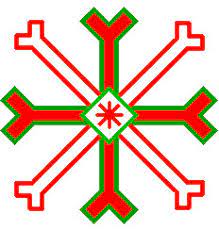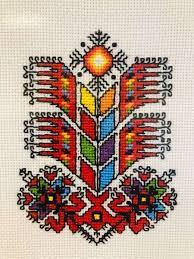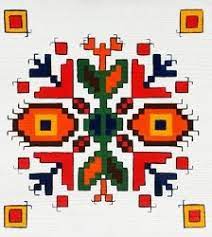From "Once upon a time - manners and worldview of the Bulgarians"
To embroider an embroidery requires skill and patience. The needle tirelessly pierces the cloth, and patterns the Bulgarian clothes and carpets with dyes and figures. Breaking through the tissue is an action that expresses fertilization. For the new life to be born, the tissue, the flesh, must be pierced. Fertilization is the continuation of the lineage, the continuation of the tradition.
It is not by chance that we have a similarity with the ornaments in Indian and Chinese similar signs in their folk motifs. Even their colors and expression is close or very similar. Our great-grandmothers always wore a long white shirt, whose skirts and sleeves they decorated with their own hands with multi-colored embroidery.
Folklore collection "Once upon a time - manners and worldview of the Bulgarians"
Народът ни приписвал магически способности на везмото. Самото везане било съпроводено от редица забрани и символични действия. Понеделник или четвъртък са били добрите дни за започване. След това девойката е прекръствала и започвала. За да спори работата на майсторката, в много краища на страната и връзвали червен конец – да я пази от зли сили. Всяка фигурка, всеки цвят и конец имали своето сакрално значение. Но те присъствали само в дрехите на момите, които още не познавали мъжка ласка, защото се смятало, че шевиците са символ на чистота, непорочност и нравствени добродетели.
Woolen thread was most often used. It was considered a symbol of wealth and fertility. For longevity and immortality, knitters used the threads of the gods - silk and gold and silver thread. The most widely used ornament was the rhombus, in all varieties. The rhombus was considered a symbol of femininity and fertility. For vitality and fertility, the maidens exported a sprig of flowers that resembled the tree of life. Various plants as decoration were inherent in the clothes of young women of childbearing age.
see more – Eight of the most common embroidery designs
Often in the old costumes we can see embroidered birds, with the rooster taking pride of place. The rooster is a symbol of life and eternal reproduction. When maidens wore embroidered roosters on their shirts or skirts, they showed that they were already ready for family life and the creation of offspring. The peacock, on the other hand, protected maidens and young brides from lessons, and this was also often found on their clothes. In the villages of Startsevo and Erma Reka in Zlatograd, women wove embroidery codes for family belonging. These are geometric symbols that were chosen so that each genus could be distinguished from the other and recognized. The code embroidery helped the young people to understand each other if they were of the same family, not to tease each other. During the forced Mohammedanization, when women were forced to walk veiled, it was the embroiderers who helped them to be recognized in the villages. The women of a clan had a specific decoration on the apron - it was like a coat of arms of the clan. The boys, when they gathered for a dance, understood which girl was from which gender by this decoration.
Unfortunately, today there is no documentary record of which embroiderer belonged to which genus. The right is the same.
 One of the most popular motifs in Bulgarian needlework is Elbetita – an ancient depiction of solar cycles and the cycle of life. The double cross shows the four directions of the world and the four most important positions of the sun - the solstices and equinoxes. The hemlock is a symbol of harmony. In different parts of the country this symbol is called by different names: "the stake", "the groshanka", "the table", "the green thread". But "elbetitsa" is the oldest and most common. Even today, some grandmothers say "elbetya", i.e. "if God has said" = "if it is right". Thus the idea of a higher order to which one must obey is introduced.
One of the most popular motifs in Bulgarian needlework is Elbetita – an ancient depiction of solar cycles and the cycle of life. The double cross shows the four directions of the world and the four most important positions of the sun - the solstices and equinoxes. The hemlock is a symbol of harmony. In different parts of the country this symbol is called by different names: "the stake", "the groshanka", "the table", "the green thread". But "elbetitsa" is the oldest and most common. Even today, some grandmothers say "elbetya", i.e. "if God has said" = "if it is right". Thus the idea of a higher order to which one must obey is introduced.
 The other ancient and popular symbol in native embroidery is Tree of Life. It is directed upwards and symbolizes growth and development, but without losing the strong connection with the root. It also embodies the cyclic nature of cosmic evolution - life, death and a new beginning. The crown of the tree is a symbol of the heavenly world, of the divine, the Trunk is the earthly world, the world of men. The roots are the world of spirits and darkness, they are the underworld. At the same time, the tree also shows the transition and division between worlds.
The other ancient and popular symbol in native embroidery is Tree of Life. It is directed upwards and symbolizes growth and development, but without losing the strong connection with the root. It also embodies the cyclic nature of cosmic evolution - life, death and a new beginning. The crown of the tree is a symbol of the heavenly world, of the divine, the Trunk is the earthly world, the world of men. The roots are the world of spirits and darkness, they are the underworld. At the same time, the tree also shows the transition and division between worlds.
© 2023 Iliana Dechkova

